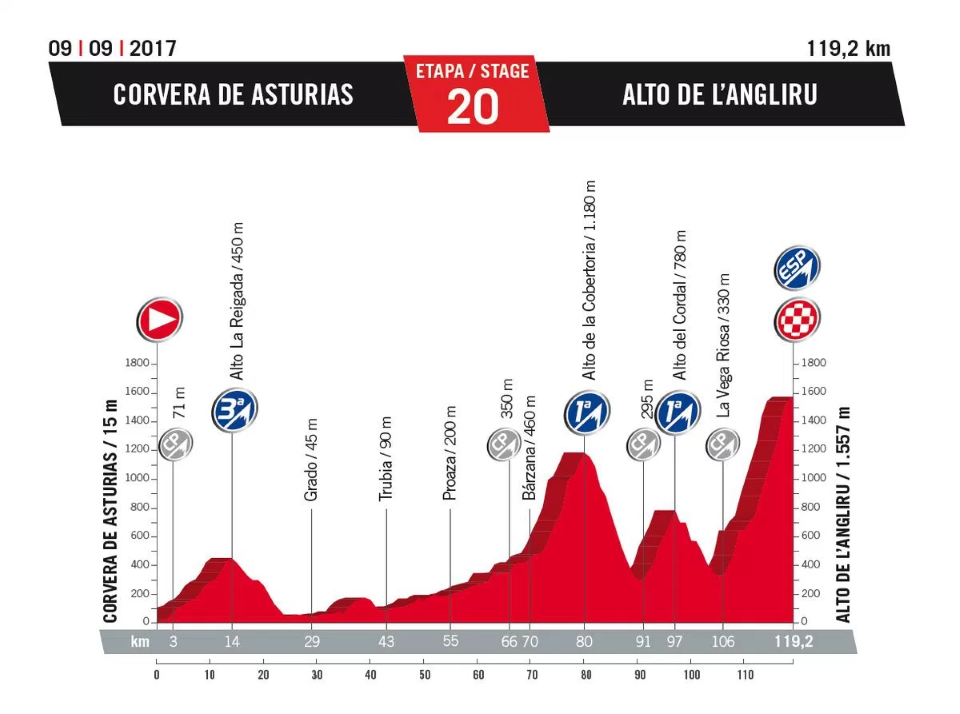The Vuelta stages you don't want to miss!
Here's our lowdown of the some of stages that could see the most dramatic and animated racing at this year's Vuelta a Espana
They all have announced their teams, ready to reach their goals from the start in Nimes, France until the arrival in Madrid on the September 10th, after 21 stages, featuring nine summit finishes, a team and individual time trial and brutal ascents of the Sierra Nevada and Angliru.
This year's route, again over the traditional 21 stages, is marginally longer and will see the peloton clock up 3,298 km (2,049 miles).
Riders will begin in France with a team time trial in the city of Nimes and then ride to French town Gruissan on the coast on day two before dipping into Spain and ending the third stage in Andorra.
They will then leave the tiny country in the Pyrenees again and enter Spain for the rest of the race. The route takes in the Mediterrenan coast as far south as the Sierra Nevada before hopping across Spain to the edge of the Atlantic Ocean for five stages.
Five mountain stages feature on the route, including the Alto de l’Angliru as well as the extraordinary Los Machucos, Monumento Vaca Pasiega, before the finish in the Spanish capital of Madrid.
You can follow the 2017 Vuelta a Espana LIVE on granfondoguide.com.
Stage 3, Monday August 21st, Prades Canigó to Andorra la Vella - 159 km Mountain Stage
It's not one of the summit finishes but stage 3 is a an early shock for the Peloton and the GC favorites. Only three days into the Vuelta a España and the riders face a tough day in the Pyrenees.
At 159 kilometres, the route takes in three passes in the high mountains before dropping down to Andorra La Vella. The race sets off in Prades, France and goes uphill cresting the Col de la Perche after 31 kilometres at 1,560 metres. The last 12 kilometres of the climb are averaging 3.7%.
After reaching Spanish soil after 114.2 kilometres, the peloton hits the slopes of the Coll de la Rabassa. The 13 kilometre climb is averages 6.9% with a steepest gradient 15.5%, with an elevation of 1,820 metres. The the Vuelta is now in Andorra.
The last climb is the Alto de la Comella, a 4 kilometre climb at 8.3%. The steepest sector of 12% is just before the top. After that it's 7.1 kilometres downhill to the finish in Andorra la Vella. The first three riders on the line take time bonuses of 10, 6 and 4 seconds, while the intermediate sprint (at kilometre 145.4) comes with 3, 2 and 1 seconds.
The 3rd stage of the 2017 Vuelta leaves at 13:20 and the finish is expected around 17:40 local time CET

Stage 11, Wednesday August 30th - Lorca to Observatorio Calar Alto - 188 km Summit Finish
Stage 11 in the Vuelta a España travels from Lorca to Calar Alto.
The flat route cuminates in a thrilling finish with the climb of the Alto de Velefique and a 16 kilometres climb to the Calar Alto observatory.
It after 71 kms at Mojácar the route begins to climb before reaching the Alto de Velefique at about 130 kms.
The climb opens with a first kilometre at 11.4% before the gradient gradually flattens out. The 13.2 kilometre climb up the Velefique is not for the faint hearted, with an average gradient of 7.3%.
The Calar Alto observatory is the largest telescope in mainland Europe, at an elevation of 2,168 metres. The 16 kilometre climb is averages 6%, with a few double digit kilometres at the start. 7km onwards and the climb is irregular with steep stretches alternating with false flats and short drops.
Last winners atop Calar Alto were Roberto Heras (2004) and Igor Antón (2006).
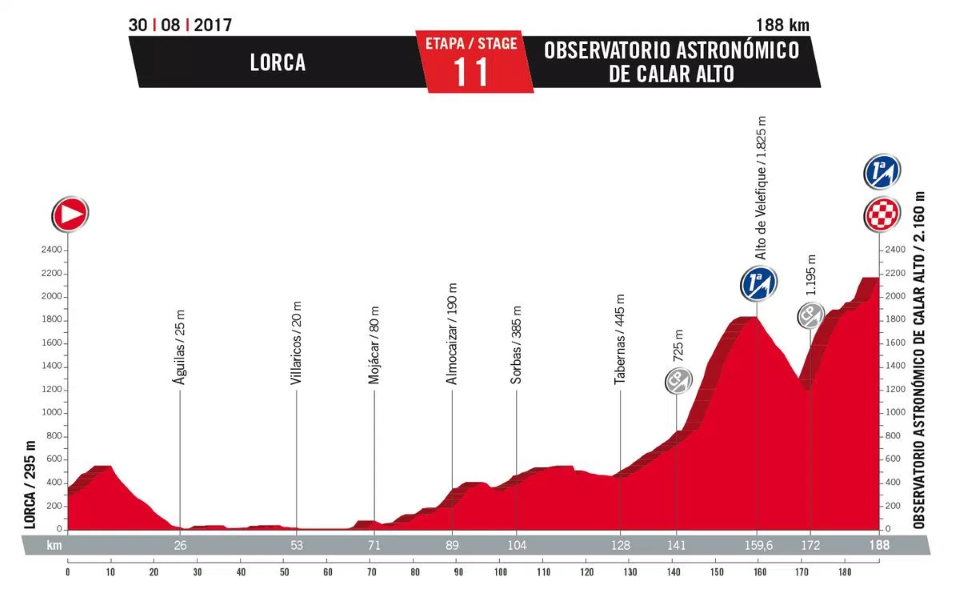
Stage 15, Sunday September 3rd - Acala La Real to Sierra Nevada - 127 km Mountain
The peloton face over 2,800 metres of climbing finishing on Alto Hoya de la Mora after climbing ovver 28 kilometres.
The start is over rolling roads towards Granada and a descent, at 30 kms the roads starts to climb to the first category Alto de Hazallanas, which amounts to 16 kilometres at 5.5%, it's the last 7 kilometres which are the toughest. This section averages more than 10%, while the steepest ramps are 22%.It plunges down 22 kilometres before the Alto de Purche appears.
Overall the Alto del Purche is 8.5 kilometres at 8% and Alto Hoya de la Mora 19.3 kilometres at 5.6%.The double climb makes for one of the toughest in cycling history at around 28.5 kilometres at 5.9% and rises to nearly 2,500 metres above sea level.
The first three riders on the line take time bonuses of 10, 6 and 4 seconds, while the intermediate sprint (at kilometre 45) comes with 3, 2 and 1 seconds.The 15th stage of the 2017 Vuelta leaves at 13:50 and the finish is expected around 17:30 local time.
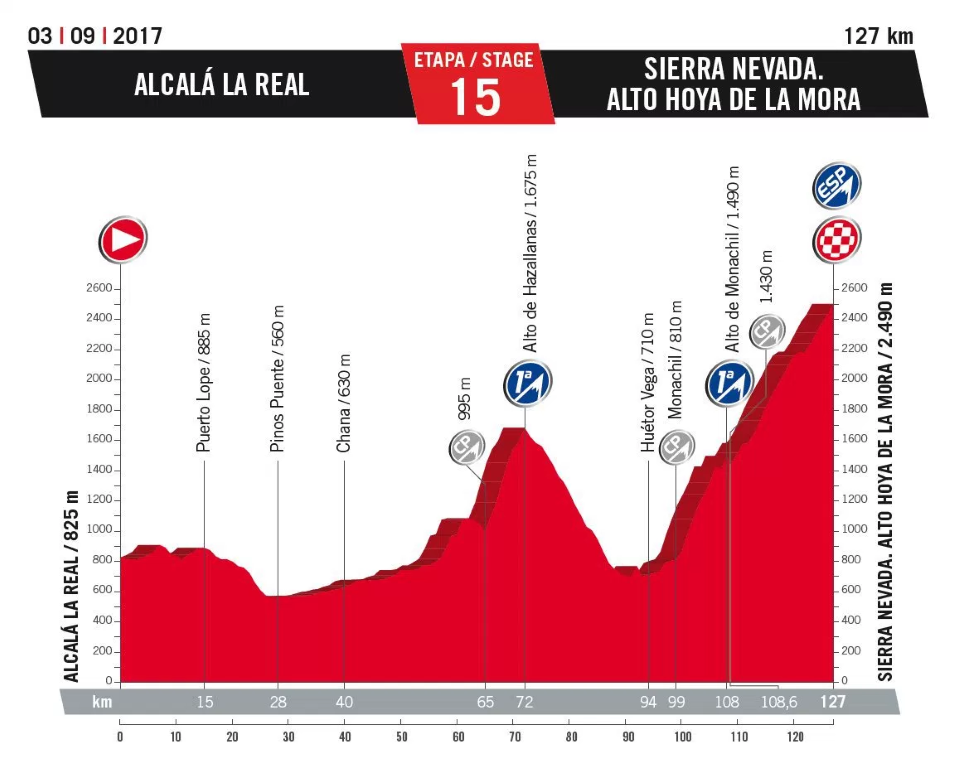
Stage 16, Tuesday September 5th - Circuito de Navarra to Logroño - 42 km ITT
After the second rest day, tghe 16th stage in the Vuelta is an individual time trial with some short nasrty climbs in the middle. The route travels from the Circuito De Navarra in Los Arcos to Logroño.
The starting ramp is on the Circuito De Navarra race track that’s also used for F-1 testing near Los Arcos .
The first 5.5 kilometres are on the race track before the riders head for Los Arcos towards Logroño.
The course runs on flat to rolling roads with the exception of the middle section which features 4 climbs of anywhere from 500m to 1 km in length at no more than 5% but will require all out efforts from riders, which will suit the better GC time trialists.
For the GC favorites whose time trialling isn't their strongest discipline, this could be a very decisive day to stay in contention.
The first rider leaves the ramp at 13:32 and the and the arrival of the last one is expected around 17:41 – both local times.
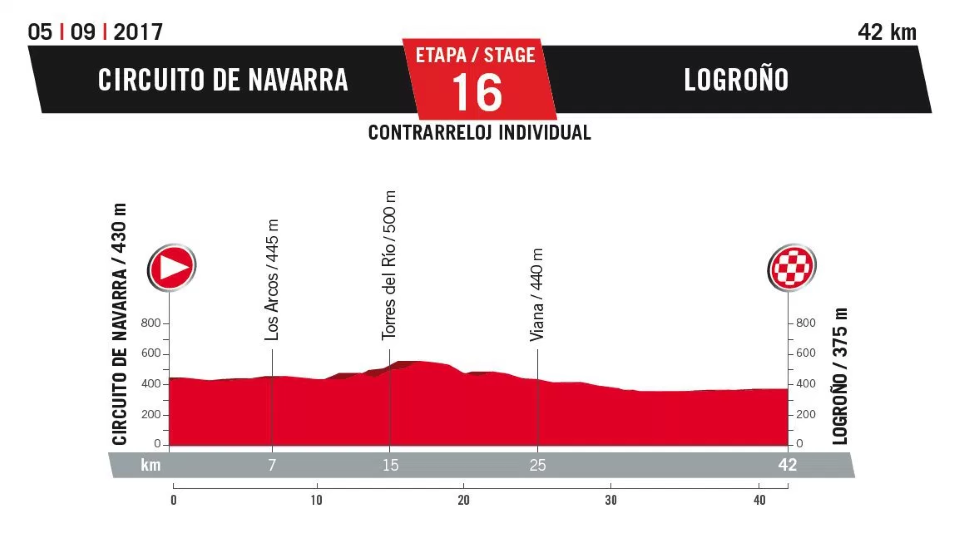
Stage 17, Wednesday September 6th - Villadiego to Los Machucos - 180 km Mountain
The 17th stage of the Vuelta a España travels from Villadiego to a finish on top of the Alto de los Machucos. This is a monster climb with steepest parts at over 30%, that's never been climbed before in La Vuelta.
The race commences in Villadiego, a little town in Northern Spain. The peloton travels further north on a plateau before the route takes a different shape at kilometre 65. A drop and a rolling section run to the base of the first climb. Portillo de Lunada amounts to 8.3 kilometres, while it is averaging 5.8% and the steepest ramps are 8.2%. La Vuelta visited the Lunada before. For instance in 2011, when Guillaume Bonnafond was the first rider to crest.
A long drop takes the riders to sea level and at kilometre 152.6 the Puerto de Alisas appears. At 10 kilometres, this climb is averaging 6% while the steepest stretches are 8.3%. So that’s fairly regular – yet tough.
After a 10 kilometres descent there will be no place to hide. The Spanish are talking about ‘rampas inhumanas’ when referring to Los Machucos. From Bustablado the climb amounts to 7.3 kilometres.
Almost straight from the start the Cantabrian mountain is a synonym for torture. After 1 kilometre the riders stumble upon a 26% grade and from this point onwards it’s all systems go. Find a cadence? Forget it! The climb is seesawing between ramps of 25% and 10% descents. The ultimate kilometre begins with a drop before a false flat last stretch.
The first three riders on the line take time bonuses of 10, 6 and 4 seconds, while the intermediate sprint (at kilometre 145.2) comes with 3, 2 and 1 seconds.
The 17th stage of the 2017 Vuelta leaves at 12:40 and the finish is expected around 17:40 – both local times (scheduled times).
Vuelta announced that stage 17 will finish atop the Alto de los Machucos with sustained gradients of 28 percent
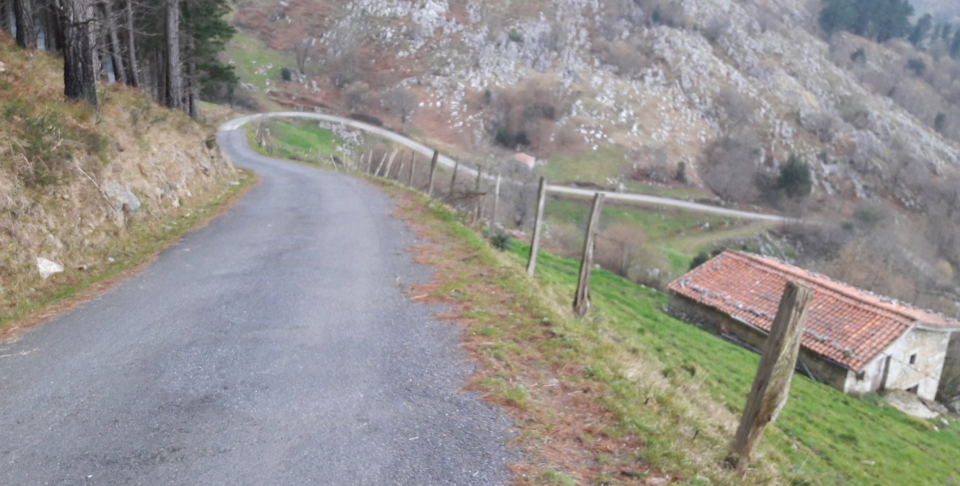
The Vuelta is no stranger to tough climbs., with frequent visits to the Alto del Angliru and Lagos de Covadonga.
The 9km long climb, with an average gradient of 9%, differs from usual climbs due to its maximum gradient. 2.5 kms into the climb, Los Machucos rears up to a leg busting 28%. The gradients do not finish there with pitches of 22% and 17% later on.
The road is so steep that parts of the surface is concrete rather than asphalt. The road is only wide enough for two bikes, which will be made even more difficult if spectators are allowed onto the climb.
The road is too steep and narrow for support cars, so riders will have to rely on neutral service bikes. Teams may use tactics like sending key riders ahead on the main peloton to offer mechanical support to their team leaders before the summit finish.
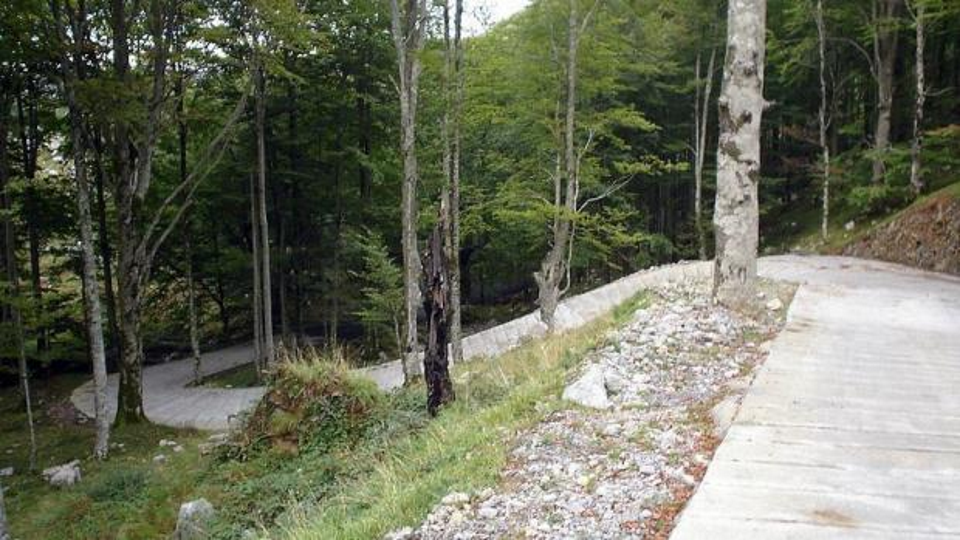
The race tackles Los Machucos at the end of the 181 km stage 17.
Los Muchucos is not the only steep summit finish, the penultimate stage will take on the fearsome Angliru, which at 12 km long features gradients of 26%.
The Angliru will play a pivotal role in the GC battle, coming late in the race.
Favourites for this year's race include Chris Froome (Team Sky) and Vincenzo Nibali (Bahrain-Merida).

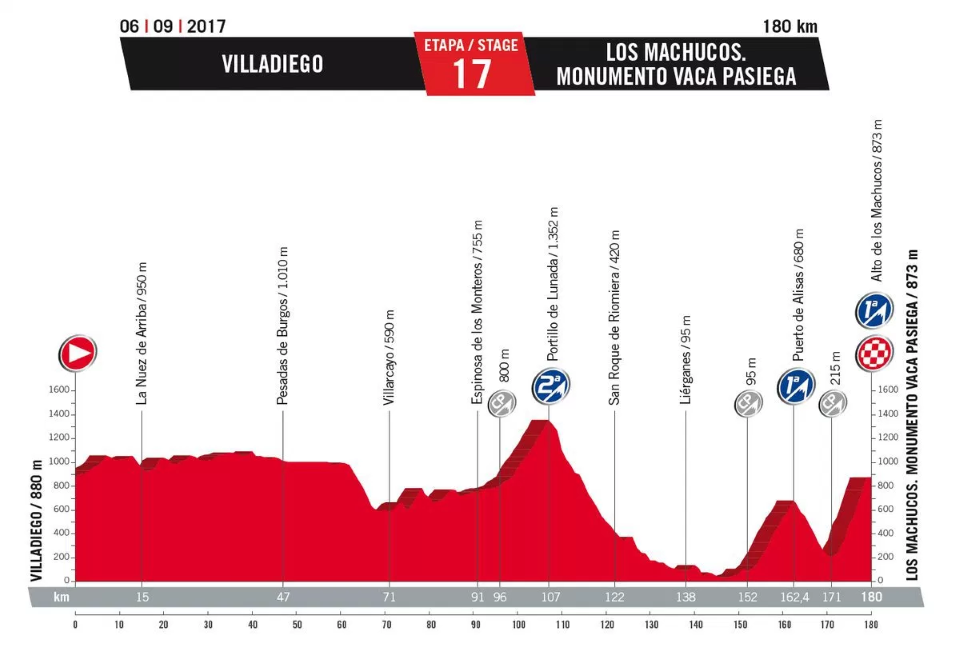
Stage 20, Saturday September 9th - Corvera to Alto de L’Angliru - 119 km Summit Finish
The 20th stage of the Vuelta a España is bound to be an amazing spectacle so don't miss it.
The stage takes in three sharp climbs in the last 50 kilometres before the summit finish on the Angliru, a 12.5 kilometre ascent with an average gradient of 9.8%.
The last mountain stage of the 2017 Vuelta a España starts in Corvera. First the peloton tackle the Alto La Reigada, a 12.7 kilometres climb, followed by 50 kilometres of alsight uphill road, until they hit the slopes of the Alto de Cobertoria.
the Alto de Cobertoria. which is an 8.1 kilometre climb with an average gradient of 8.6%. Straight after the descent they climb the steep Alto de Cordal, 5.7 kilometre climb averaging 8.6%, while the steepest gradient of 12% comes 1 kilometre before the top.
The worst is yet to come, the Alto de El Angliru, summit finish climb is 12.5 kilometres comes with an average gradient of 9.8%, while the steepest gradients are over 23.5%.
There are three steps to the Angliru. The first 5 kilometres goes up at 8% and following a relatively flat kilometre the rest of the rest of the is brutal.
The second half of the climb is a cursed average gradient of 15%. But riders will face the steepest part at 23.5%, aptly named Cueña les Cabres (goat path), with 3 kilometres remaining.
The first three riders on the line take time bonuses of 10, 6 and 4 seconds, while the intermediate sprint (at kilometre 89.5) comes with 3, 2 and 1 seconds.
The 20th stage of the 2017 Vuelta leaves at 14:20 and the finish is expected around 17:40 both local time CET.
